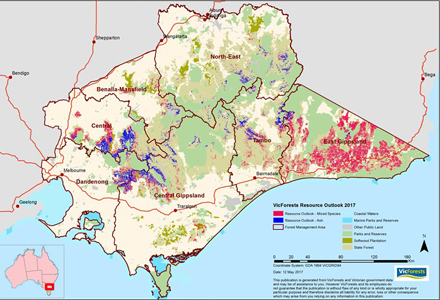
VicForests has released its 2017 Resource Outlook which forecasts the amount of high quality timber that can be commercially supplied from State forests in eastern Victoria on a sustainable basis. Source: Timberbiz
Nathan Trushell, Acting CEO VicForests said the Resource Outlook is developed using a range of systems and processes.
“The Outlook models how much wood is in the available forest, how much it will grow over time and how much timber is likely to be produced when harvested,” Mr Trushell said.
“We have invested heavily in improving this modelling process over recent years.
“The model is updated regularly to account for changes in the forest and market conditions and the results are used to forecast future sales and guide timber harvesting levels. VicForests separate the timber species they supply into two categories, ash and mixed species. The 2017 Resource Outlook forecasts mixed-species sawlog supply to yield between 100 000m3 and 115 000 m3 each year for the next five years. Ash sawlog supply is forecast to be at a level of 153 000m3 per year for the next three years and then 130 000m3 per year from 2020/21.
“The forecast for available ash sawlog has reduced by 88 000m3 per year since the 2013 Resource Outlook,” Mr Trushell said.
“This reduction is a result of modelling current and future impacts on the available ash supply including an equivalent of the recent rate of Leadbeater’s possum detections continuing for seven years,” he said.
When modelling future timber resources VicForests look at a range of new information including; changes to the forest appearance harvesting, wildfires and other events that can alter the age and structure of the forest data about the forest structure and mix of tree species from remote-sensing information about the amount of timber that may be produced changes to the available area due to regulatory and policy decisions.
“Each time we review the Resource Outlook a wide range of scenarios are tested to determine the potential impacts on how much timber we can harvest, future timber supply and long-term sustainability,” Mr Trushell said.
“We then assess the risk of factors that could potentially impact future timber resource availability and adjusts the modelling to determine medium-term, future timber sales,” he said.
VicForests Resource Outlook has been assessed by the Victorian Auditor General’s Office and more recently by the Victorian Environmental Assessment Council (VEAC) in April 2017.
The VEAC report specifically looked at our 2017 Resource Outlook and agreed with VicForests modelling method.
“VicForests modelling approach is sound and the sustainable harvest levels are reasonable,” the VEAC report said.
In addition to high quality sawlogs, timber harvesting operations produce low quality sawlogs, pulp logs, firewood and other timber products that are also made available for sale.
VicForests aims to ensure that timber harvesting levels in Victoria’s State forests are managed on a long term sustainable basis and currently harvests and re-grows approximately 0.04% of Victoria’s publicly owned forest per year.
For more information on the 2017 Resource Outlook please visit www.vicforests.com.au/resourceoutlook- 2017





